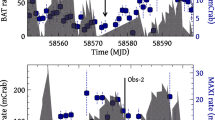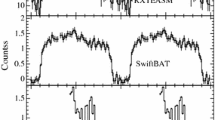Abstract
Purpose
In order to carry out in-orbit calibration, the hard X-ray modulation telescope satellite (HXMT) has made a number of observations of Crab pulsar. We study the long-term evolution of the X-ray flux of the Crab pulsar with these observational data.
Methods
We use nearly four years Crab pulsar’s data obtained by HXMT and the neutron star interior composition of explorer to test whether \(L_\textrm{x} \propto L_\textrm{sd}^{\alpha }\) holds for an individual pulsar, where \(L_\textrm{x}\) is the pulsed X-ray luminosity and \(L_\textrm{sd}\) is its spin-down luminosity. We also combine the earlier results obtained with PCA and HEXTE data (Yan et al. in ApJ 865:21, 2018) to get the long-term evolution characteristics of the Crab pulsar.
Results
We find the X-ray flux evolution can be fitted by a linear correlation: \(L_\textrm{x} \propto L_\textrm{sd}^{1.42\pm 0.18}\). In soft X-ray energy band (1–10 keV) and hard X-ray energy band (27–250 keV), \(\alpha \) does not change significantly with either energy or phase. However, this will need to be confirmed in future. For example, the interpulse component of hard X-ray may follow \(L_\textrm{x}\propto L_\textrm{sd}^{0.96\pm 0.34}\), which may be different from the correlation of soft X-rays and main pulse component. On the other hand, the hard X-ray flux evolution shows that the performance of high energy X-ray telescope (HE) onboard HXMT, such as effective area, is stable.
Conclusion
We conclude that the X-ray luminosity of the Crab pulsar closely correlates with its spin-down luminosity. However, the emission mechanism responsible for these phenomena remains not fully understood.







Similar content being viewed by others
References
F.D. Seward, Z.R. Wang, ApJ 332, 199 (1988)
W. Becker, J. \(Tr\ddot{u}\)mper, A &A 326, 682 (1997)
Y. Saito, Ph.D. Thesis, Univ. of Tokyo (S98) (1998)
A. Possenti, R. Cerutti, M. Colpi, S. Mereghetti, A &A 387, 993 (2002)
K.S. Cheng, R.E. Taam, W. Wang, ApJ 617, 480 (2004)
X.H. Li, F.J. Lu, Z. Li, ApJ 682, 1166 (2008)
O. Kargaltsev, M. Durant, G. Pavlov, G. Garmire, ApJS 201, 37 (2012)
L.L. Yan, M.Y. Ge, F.J. Lu et al., ApJ 865, 21 (2018)
W. Becker, ASSL 357, 91–141 (2009)
S.N. Zhang, T.P. Li, F.J. Lu et al., Sci. China. Phys. Mech. Astron. 63(4), 249502 (2020)
C.Z. Liu, Y.F. Zhang, X.F. Li, et al., Sci. China Phys. Mech. Astron. 63(4), 249503 (2020)
X.L. Cao, W.C. Jiang, B. Meng, et al., Sci. China Phys. Mech. Astron. 63(4), 249504 (2020)
Y. Chen, W.W. Cui, W. Li, et al., Sci. China, Phys. Mech. Astron. 63(4), 249505 (2020)
X.B. Li, X.F. Li, Y. Tan et al., JHEAP 27, 64 (2020)
A.G. Lyne, R.S. Pritchard, F.G. Smith, MNRAS 265, 1003 (1993)
M. Vivekanand, A &A 649, A140 (2021)
M.Y. Ge, F.J. Lu, J.L. Qu et al., ApJS 199, 32 (2012)
L.L. Yan, Y.L. Tuo, M.Y. Ge et al., ApJ 928, 183 (2022)
V. Trimble, PASP 85, 579 (1973)
M.Y. Ge, L.L. Yan, F.J. Lu et al., ApJ 818, 48 (2016)
K.K. Madsen, F.A. Harrison, C.B. Markwardt et al., ApJSS 220, 8 (2015)
K.K. Madsen, K. Forster, B. Grefenstette et al., JATIS 8(3), 034003 (2022)
T. Kouzu, M.S. Tashiro, Y. Terada et al., PASJ 65, 74 (2013)
C.C. Wilson-Hodge, M.L. Cherry, G.L. Case et al., ApJ 727, L40 (2011)
S.N. Zhang, Y. Xie, APJ 761, 102 (2012)
S.X. Yi, S.N. Zhang, MNRAS 454, 3674–3678 (2015)
J.K. Daugherty, A.K. Harding, ApJ 458, 278 (1996)
K.S. Cheng, C. Ho, M. Ruderman, ApJ 500, 522 (1986)
R.W. Romani, ApJ 470, 469 (1996)
Acknowledgements
This work used data from the Insight-HXMT mission, a project funded by the China National Space Administration (CNSA) and the Chinese Academy of Sciences (CAS). We gratefully acknowledge the support from the National Program on Key Research and Development Project (Grant No. 2021YFA0718500) from the Minister of Science and Technology of China (MOST). The authors thank supports from the National Natural Science Foundation of China under Grants U1938102, 12273043, U1838201, U1838202, U1938109 and U1938108. This work was partially supported by International Partnership Program of Chinese Academy of Sciences (Grant No. 113111KYSB20190020).
Author information
Authors and Affiliations
Corresponding author
Rights and permissions
Springer Nature or its licensor (e.g. a society or other partner) holds exclusive rights to this article under a publishing agreement with the author(s) or other rightsholder(s); author self-archiving of the accepted manuscript version of this article is solely governed by the terms of such publishing agreement and applicable law.
About this article
Cite this article
Zhao, HS., Ge, MY., Li, XB. et al. Long-term evolution of the X-ray flux of the Crab pulsar. Radiat Detect Technol Methods 7, 48–55 (2023). https://doi.org/10.1007/s41605-023-00392-2
Received:
Revised:
Accepted:
Published:
Issue Date:
DOI: https://doi.org/10.1007/s41605-023-00392-2




